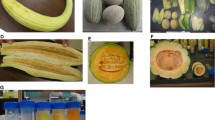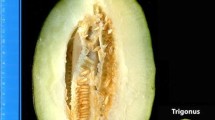Abstract
Growing environment dramatically influences melon (Cucumis melo L.; 2n = 2x = 24) fruit development and quality. Consequently, the characterization of quantitative trait loci (QTL) controlling melon fruit quality for application in marker-assisted selection (MAS) requires an assessment of genotype by environmental interactions, trait correlations, and QTL efficacy. Therefore, fruit quality traits [soluble solids content (SSC), mesocarp pressure (MP), fruit diameter (mesocarp + exocarp; FD), seed cavity diameter (endocarp; SCD), seed cavity to FD ratio (C:D), fruit shape (FS), and percentage of exocarp netting (PN) at time of harvest] were examined in 81 recombinant inbred lines (RIL) at two growing locations (California. and Wisconsin, USA) to identify the map position and consistency of QTL for MAS in a Group Cantalupensis U.S. Western Shipping market type background. RIL developed from a cross between U.S. Department of Agriculture line USDA-846-1 and ‘Top Mark’ were used to identify 57 QTL in both location tested (SSC = 10, MP = 8, FD = 6, SCD = 9, C:D = 8, PN = 6, and FS = 10). The QTL were distributed across 12 linkage groups and explained a significant portion of the associated phenotypic variation (R 2 = 4–29%). Twelve of such QTL were consistently identified in the two locations tested [SSC (ssc7.4 and ssc10.8), MP (mp7.2, mp10.3, and mplg7.5), SCD (scd1.1, scd5.4, and scd8.5), C:D (cd2.1), and PN (pn2.1), FS (fs1.1 and fs2.3)]. The map positions of 18 QTL (FS = 7, SSC = 6, C:D = 3, SCD = 1, and PN = 1) were in equivalent (i.e., collinear) genomic regions with previous studies in Group Inodorus-based maps. Six of the collinear QTL were detected in both locations in our study (ssc7.4, ssc10.8, fs1.1, fs2.3, pn2.1, and scd5.4). The collinearity of these QTL with those identified in other maps, and their consistency across diverse growing environments portends their broad applicability in melon MAS.



Similar content being viewed by others
Abbreviations
- BLUPs:
-
Best linear unbiased predictions
- BLUEs:
-
Best linear unbiased estimations
- FD:
-
Fruit diameter
- FS:
-
Fruit shape
- MP:
-
Mesocarp pressure
- PN:
-
Percent netting at full-slip
- C:D:
-
SCD:FD ratio
- SCD:
-
Seed cell diameter
- SSC:
-
Soluble solids content
References
Baudracco-Arnas S, Pitrat M (1996) A genetic map of melon (Cucumis melo L) with RFLP, RAPD, isozyme, disease resistance and morphological markers. Theor Appl Genet 93:57–64
Beavis WD (1998) QTL analysis: power, precision, and accuracy. In: Paterson AH (ed) Molecular dissection of complex traits. CRC Press, Boca Raton, FL, pp 145–162
Bernardo R (1996) Best linear unbiased prediction of maize single-cross performance. Crop Sci 36:50–56
Broman KW, Wu H, Sen S, Churchill GA (2003) R/qtl: QTL mapping in experimental crosses. Bioinformatics 19:889–890
Churchill GA, Doerge RW (1994) Empirical threshold values for quantitative mapping. Genetics 138:963–971
Danin-Poleg Y, Reis N, Baudracco-Arnas S, Pitrat M, Staub JE, Oliver M, Arus P, de Vincente CM, Katzir N (2000) Simple sequence repeats in Cucumis mapping and map merging. Genome 43:963–974
Danin-Poleg Y, Tadmor Y, Tzuri G, Reis N, Hirschberg J, Katzir N (2002) Construction of a genetic map of melon with molecular markers and horticultural traits, and localization of genes associated with ZYMV resistance. Euphytica 125:373–384
de Leon N, Coors JG, Kaeppler SM, Rosa GJM (2005) Genetic control of prolificacy and related traits in the golden glow maize population: I phenotypic evaluation. Crop Sci 45:1361–1369
Dogimont C, Leconte L, Périn C, Thabuis A, Lecoq H, Pitrat M (2000) Identification of QTLs contributing to resistance to different strains of cucumber mosaic cucumovirus in melon. Acta Hortic 510:391–398
Eduardo I, Arus P, Montforte AJ, Martinez JA, Alarcon AL, Alvarez JM, Knapp E (2007) Estimating the genetic architecture of fruit quality traits in melon using a genomic library of near isogenic lines. J Am Soc Hortic Sci 132:80–89
Falconer DS, Mackay TF (1996) Introduction to quantitative genetics, 4th edn edn. Longman Group, London, UK
Gonzalo MJ, Oliver M, Garcia-Mas J, Monfort A, Dolcet-Sanjuan R, Katzir N, Arús P, Monforte AJ (2005) Development of a consensus map of melon (Cucumis melo L) based on high-quality markers (RFLPs and SSRs) using F2 and double-haploid line populations. Theor Appl Genet 110:802–811
Kalb TJ, Davis DW (1984) Evaluation of combining ability, heterosis, and genetic variance for fruit quality characteristics in bush muskmelon. J Am Soc Hortic Sci 109:411–415
Katzir N, Danin-Poleg T, Tzuri G, Karchi Z, Lavi U, Cregan PB (1996) Length polymorphism and homologies of microsatellites in several Cucurbitaceae species. Theor Appl Genet 93:1282–1290
Kubicki B (1962) Inheritance of some characters in muskmelon (Cucumis melo L). Genet Pol 3:265–274
Lippert LF, Legg PD (1972) Appearance and quality characters in muskmelon fruit evaluated by ten-cultivar diallel cross. J Am Soc Hortic Sci 97:84–87
Lippert LF, Hall MO (1982) Hertiabilities and correlations in muskmelon from parent offspring regression analyses. J Am Soc Hortic Sci 107:217–221
Littell RC, Milliken GA, Stroup WW, WolWnger RD (1996) SAS system for mixed models. SAS Institute Inc., Cary, NC
McCreight JD, Nerson H, Grumet R (1993) Melon, Cucumis melo L. In: Kallos G, Bergh BO (eds). Genetic improvement of vegetable crops. Pergamon Press, New York
Monforte AJ, Oliver M, Gonzalo MJ, Alvarez JM, Dolcet-Sanjuan R, Arus P (2004) Identification of quantitative trait loci involved in fruit quality traits in melon (Cucumis melo L). Theor Appl Genet 108:750–758
Obando J, Fernandez-Trujillo JP, Martinez AL, Alarcon AL, Eduardo I, Arus P, Monforte J (2008) Identification of melon fruit quality quantitative trait loci using near-isogenic lines. J Am Soc Hortic Sci 133:139–151
Oliver M, Garcia-Mas J, Cardus M, Puedo N, Lopez-Sese A, Arroyo M, Gomez-Paniagua H, Arus P, de Vincente MC (2001) Construction of a reference linkage map for melon. Genome 44:836–845
Paris M, Staub JE, McCreight J (2003) Determination of fruit sampling location for quality measurements in melon (Cucumis melo L). Cucurbit Genet Coop Rpt 26:12–17
Perchepied L, Dogimont C, Pitrat M (2005a) Strain-specific and recessive QTLs involved in the control of partial resistance to Fusarium oxysporum f. sp melon race 1.2 in a recombinant inbred line population of melon. Theor Appl Genet 111:65–74
Perchepied L, Dogimont C, Pitrat M (2005b) Relationship between loci conferring downy and powderly mildew resistance in melon assessed by quantitative trait loci mapping. Phytopathology 95:556–565
Perin C, Dogimont C, Giovanazzo N, Besombes D, Guitton L, Haggen L, Pitrat M (1999) Genetic control and linkages of some fruit characters in melon. Cucurbit Genet Coop Rpt 22:16–18
Perin C, Hagen LS, Giovinazzo N, Besombes D, Dogimont C, Pitrat M (2002a) Genetic control of fruit shape acts prior to anthesis in melon (Cucumis melo L). Mol Genet Genom 266:933–941
Perin C, Gomez-Jimenez M, Hagen L, Dogimont C, Pech JC, Latche A, Pitrat M, Lelievre JM (2002b) Molecular and genetic characterization of a non-climacteric phenotype in melon reveals two loci conferring altered ethylene response in fruit. Plant Physiol 129:300–309
Perin C, Hagen LS, de Conto V, Katzir N, Danin-Poleg Y, Portnoy V, Baudracco-Arnas S, Chadoeuf J, Dogimont C, Pitrat M (2002c) A reference map of Cucumis melo based on two recombinant inbred line populations. Theor Appl Genet 104:1017–1034
Pitrat M (2002) Melon gene list for melon. Curcubit Genet Coop Rpt 25:76–93
SAS Institute (1999) SAS version 8.02 for windows. SAS Institute Inc Cary, NY
Silberstein L, Kovalski I, Brotman Y, Perin C, Dogimont C, Pitrat M, Klingler J, Thompson G, Portnoy V, Katzir N, Perl- Treves R (2003) Linkage map of Cucumis melo including phenotypic traits and sequence-characterized genes. Genome 46:761–773
Stepansky A, Kovalski I, Perl-Treves R (1999) Intraspecific classification of melons (Cucumis melo L) in view of their phenotypic and molecular variation. Plant Syst Evol 217:313–332
Wang YH, Thomas CE, Dean RA (1997) A genetic map of melon (Cucumis melo L) based on amplified fragment length polymorphism (AFLP) markers. Theor Appl Genet 95:791–798
Wang S, Basten CJ, Zeng ZB (2001–2004) Windows QTL Cartographer 2.0. Department of Statistics, North Carolina State University, Raleigh, NC (http://statgen.ncsu.edu/qtlcart/WQTLCart.htm)
Yan W, Rajcan I (2003) Prediction of cultivar performance based on single- versus multiple- year tests in soybean. Crop Sci 43:549–555
Zalapa (2005) Inheritance and mapping of plant architecture and fruit yield in melon (Cucumis melo L). PhD Dissertation, University of Wisconsin, Madison
Zalapa JE, Staub JE, McCreight JD (2006) Generation means analysis of plant architectural traits and fruit yield in melon. Plant Breed 125:482–487
Zalapa JE, Staub JE, McCreight JD, Chung SM, Cuevas H (2007) Detection of QTL for yield-related traits using recombinant inbred lines derived from exotic and elite US Western Shipping melon germplasm. Theor Appl Genet 114:1185–1201
Zeng ZB (1994) Precision mapping of quantitative trait loci. Genetics 136:1457–1468
Author information
Authors and Affiliations
Corresponding author
Additional information
Miriam K. Paris, Juan E. Zalapa contributed equally to the work described in this manuscript.
Rights and permissions
About this article
Cite this article
Paris, M.K., Zalapa, J.E., McCreight, J.D. et al. Genetic dissection of fruit quality components in melon (Cucumis melo L.) using a RIL population derived from exotic × elite US Western Shipping germplasm. Mol Breeding 22, 405–419 (2008). https://doi.org/10.1007/s11032-008-9185-3
Received:
Accepted:
Published:
Issue Date:
DOI: https://doi.org/10.1007/s11032-008-9185-3




